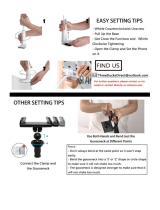Page is loading ...

5
ENGLISH
The gooseneck microphone SM-NR-1 to be installed into helmets
1 Noise compensated microphone with close talking characteristics
2 Flexible gooseneck
3 Aluminium housing for control electronics
4 Polarity safe connecting plug
5 Black foam windshield
6 Mounting clamp
7 Protected connecting cable
Important!
Range of use
Before starting with the installation, please read this instruction
carefully!
The gooseneck microphone SM-NR-1 can be used with all motorbike
communication systems of the eries. It is equipped
with a close talking characteristics for an optimum driving noise compensa-
tion and is designed to be used with jet helmets or with flip-up helmets,
when driving open.
With full-face helmets we recommend the installation of our active micro-
phone AKE W-NR-2 which was especially designed for this kind of applicati-
on.
AKE - PowerCom s
ENGLISH

6
ENGLISH
The installation of the gooseneck microphone
Installation into helmets with cheek padding
Before the installation, please remove the black foam windshield to get the
exact position of the microphone exit.
IMPORTANT!
A close talking microphone can only work properly when it is installed
centrically and close to the mouth and the back microphone exit is running
parallel to the mouth.
The SM-NR-1 has been designed symmetrically, therefore it does’nt matter
which side of the two exits points to the back. Nevertheless, it is important
that the exist pointing to the back is running parallel to the mouth.
The mounting clamp is designed that the gooseneck microphone can be
installed in various helmet types:
Using the assembly clamp, the gooseneck microphone SM-NR-1 can be
installed either on the right or left side on top of the cheek padding.
Just choose the side you prefer.
Lead the connecting cable of the
microphone through the assembly
clamp.
Put the assembly clamp onto the
bigger part of the gooseneck
microphone. Now lead the connec-
ting cable to a space where you can
easily connect the helmet connection
cable.
Depending on the helmet used there
are various possibilities to install the
assembly clamp. If the padding is
permanently attached you can just
press the thorns between the outer
lining and the styrofoam. To get additional footing you can bend up the barbed
hook variantly to both sides or you can affix the even side at the bottom.

7
ENGLISH
If this is not efficient enough, there are
two drill holes for screws.
Now bring the microphone into the right
position (the gooseneck can be turned
and moved inside the mounting clamp).
If the gooseneck can be turned too
easily, than we recommend to have it
affixed with an adhesive.
Do not forget to put the black foam
windshield back onto the microphone.
For Helmets without cheek padding read
the following.
With helmets without cheek padding, the gooseneck microphone can either be
pressed in between the upper and lower part of the styrofoam padding or a drill
hole less than 8 mm has to be made into the padding so that the back part of
the gooseneck can be affixed there.
Choose a proper place for your installation. Drill, if applicable, a hole using a
quality drill with low rotation speed. Lead the connecting cable under the
padding to make a connection to the helmet connecting cable possible. Affix the
microphone, if necessary, with an adhesive that is suitable for styrofoam.
Do not forget to put the black foam windshield back onto the microphone.
For the installation of the helmet loudspeakers and the helmet connecting cable
please refer to the applicable installation instructions.
Installation into helmets without cheek padding
Technical data
Transducer: Noise reduced electret
: < 3,3 KOhm
Power supply: 0,6 mA
Directivity with housing: Super-8
Sound pressure: -64 dB (0dB=1V/µBar)
Ambient noise compensation > 20 dB
Signal modulation (k=10%) > 112 dB
DC internal resistance
/



